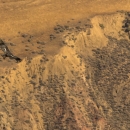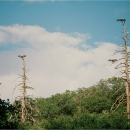About Us
A high mountain valley encircled by deep canyons, steep ridgelines, and rocky pinnacles, Hopper Mountain National Wildlife Refuge is the gateway into California condor country. The refuge is an outpost on the edge of an unforgiving terrain where California condors safely forage, nest, and roost. Under the wing of these majestic birds, the refuge supports healthy examples of oak woodlands, grasslands, chaparral, coastal sage scrub, seasonal wetlands, riparian riparian
Definition of riparian habitat or riparian areas.
Learn more about riparian areas, and some of the last remaining intact stands of California black walnut.
Decorating the rock spires where condors now perch, preserved Chumash rock art symbolizes the connection these indigenous people have to the land and sacred bird. Hopper Mountain NWR emanates a sense of stewardship and conservation to neighboring lands. The refuge exemplifies productive relationships with neighboring landowners and partners. Refuge facilities serve as resources for the scientific community and academic institutions to conduct research supporting refuge purposes.
This 2,471-acre refuge adjoins the southern boundary of the Sespe Condor Sanctuary, a component of the U.S. Forest Service, Los Padres National Forest. The 53,000-acre Sanctuary contains critical California condor nesting and roosting habitat. Strategically located adjacent to the Sanctuary, the refuge helps buffer these nesting and roosting areas from human disturbance and protects a portion of the foraging habitat within a much larger area where the condors have historically foraged and fed. Hopper Mountain NWR also protects a variety of plant communities that provide habitat for other species protected under the federal Endangered Species Act.
The National Wildlife Refuge System:
The U.S. Fish and Wildlife Service manages an unparalleled network of public lands and waters called the National Wildlife Refuge System. With more than 560 refuges spanning the country, this system protects iconic species and provides some of the best wildlife viewing opportunities on Earth.
The National Wildlife Refuge System lands and waters serve a purpose distinct from that of other U.S. public lands: Wildlife conservation drives everything on national wildlife refuges, from the purposes for which each refuge was established, to the recreational activities offered, to the resource management tools used.
Our Mission
The mission of the National Wildlife Refuge System is to administer a national network of lands and waters for the conservation, management and, where appropriate, restoration of the fish, wildlife and plant resources and their habitats within the United States for the benefit of present and future generations of Americans.
Our History
On March 14, 1903, President Theodore Roosevelt established Pelican Island National Wildlife Refuge, along Florida’s Atlantic coast, as the first unit of what would become the National Wildlife Refuge System.




